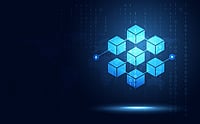In recent times, two transformative technologies have reshaped the digital world — Artificial Intelligence (AI) and Blockchain. Each of them has evolved singly, working complex problems and unleashing new ways of thinking. But a new shift is passing. These technologies are now being combined to produce decentralized AI platforms. This emulsion isn't just a trend but an important movement aimed at addressing critical issues like data sequestration, trust, power, and global collaboration.
Understanding the Two Technologies
Before we dive into their integration, it’s important to understand what makes these technologies so poignant.
Artificial Intelligence is a term used to describe how machines can replicate human intelligence. AI systems have the capacity to learn from information, make choices, identify patterns, and even make forecasts on what might happen in the future. They're being used in a wide range of diligence — healthcare, finance, manufacturing, and more.
Blockchain, on the other hand, is a distributed ledger system. It securely records deals across a network of computers in a way that's tamper- evidence and transparent. It removes the need for centralized authorities by using agreement mechanisms to validate data. This technology is extensively known for enabling cryptocurrencies, but its use extends far beyond that.
Now imagine combining the decision- making power of AI with the trust and translucency of blockchain. This is what decentralized AI platforms are trying to achieve.
The Problem with consolidated AI
presently, utmost AI models are possessed and controlled by large pots. These companies gather massive quantities of data — frequently without stoner concurrence — and use it to train important algorithms. Users have little visibility or control over how their data is used. Also, the AI models are stored on private waiters, which means they're vulnerable to security breaches or prejudiced manipulation.
This centralized model creates issues related to
Data privacy
Bias and lack of transparency in AI models
Single points of failure
Lack of trust in labors and opinions
How Blockchain Complements AI
When blockchain is combined with AI, several of these issues can be addressed
1. Transparency and Trust: Blockchain can record every action taken by an AI model. Whether it's training, data sources, or decision- making paths, each exertion can be logged and vindicated. This creates trust in how AI reaches conclusions.
2. Data Power and Consent: Blockchain allows users to control their data. Smart contracts — programs stored on a blockchain — can be used to give authorization for data use. This means individualities can choose when and how their data is used for AI training.
3. Decentralized Computing Power: AI requires high computational coffers. In decentralized AI platforms, users across the globe can offer their computing power in exchange for impulses, creating a global network of contributors without a central authority.
4. Global Collaboration: Blockchain networks are borderless. This allows experimenters, inventors, and data contributors from around the world to work together on erecting better AI systems.
5. Security and Adaptability: With no single point of failure, decentralized platforms are less vulnerable to hacking and suppression.
Real- World operations of Decentralized AI
Decentralized AI platforms can be used in a variety of diligence.
In healthcare, AI can dissect large quantities of patient data to find trends or prognosticate ails. Using blockchain, this data can be participated securely without revealing particular individualities.
In the financial sector, fraud discovery models can be made more transparent and secure when the decision sense is recorded on a blockchain.
In supply chain operation, AI models can prognosticate detainments or optimize routes. Blockchain can ensure that each step in the force chain is vindicated and cannot be changed.
These use cases punctuate how the combination of AI and blockchain can give further value than when used independently.
Challenges and the Road Ahead
There are challenges that inventors and experimenters must overcome.
One major issue is scalability. AI requires large quantities of data and calculating power, which may be delicate to manage on a decentralized network without causing detainments.
Another challenge is standardization. For decentralized AI to work globally, there must be common rules and fabrics for how data is participated and how AI models are trained and estimated.
There’s also the concern of energy operation, especially when using blockchain networks that calculate on energy- ferocious agreement mechanisms. Moving toward further sustainable blockchain protocols is essential.
Eventually, regulations and laws are still catching up with these technologies. icing that data sequestration laws are admired while encouraging invention is a delicate balance that every country must address.
Why This Matters Now
As we move into a more digital and data- driven world, the way we use and trust technology will shape our future. The emulsion of blockchain and AI offers a path to further popular, secure, and transparent systems. It puts control back in the hands of users and opens the door to global invention without counting on large tech monopolies.
This isn't just about erecting new technologies, it's about redefining how technology can serve people, not just pots. Decentralized AI platforms could mark a shift in how we make intelligent systems from closed to open, from controlled to participatory, from private to collaborative.





















